
Health enthusiasts often embrace smartwatches as an innovative way to monitor their stress levels. However, a recent study published in the Journal of Psychopathology and Clinical Science casts doubt on this widely held belief. The research suggests that these wearable devices may have a limited ability to accurately represent an individual’s psychological state. According to researchers, there are instances when a smartwatch may perceive a user as stressed when they are merely excited about an event.
The study analyzed nearly 800 students who wore a Garmin Vivosmart 4 smartwatch. The researchers measured the participants' self-reported emotional states and compared them with the metrics collected by the wearable devices. The findings revealed a significant discrepancy between the self-reports of the watch-wearers and the analyses provided by the smartwatches. The researchers noted, “We investigated the concurrent overlap between self-report and wearable sensor data measuring stress, tiredness, and sleep. For the majority of individuals in our sample, we found that self-report and physiological measures of stress show very weak to no associations.”
Garmin promotes the stress-tracking capabilities of its smartwatches on its official website. The company states, “Stress levels (0–100) are estimated by the Firstbeat Analytics engine, primarily using a combination of heart rate (HR) and heart rate variability (HRV) data.” This data is gathered by an optical heart rate sensor located on the back of the device. However, Garmin acknowledges the complexities involved in measuring the quality and character of stress. The company points out that different situations, such as public speaking or running up a flight of stairs, can cause an elevated heart rate but arise from fundamentally different emotional states.
Garmin advises users to wear their devices more frequently to enhance measurement accuracy. “You can improve the quality of the insight gained by wearing your device as much as possible, especially while you sleep, because that is when your stress levels will typically be lowest,” the website suggests. This practice aims to provide a better understanding of the full range of stress and relaxation states experienced by users.
In an interview with The Guardian, Eiko Fried, one of the authors of the study, emphasized the weak correlation between the self-reported stress scores and the readings from the smartwatches. He stated that the correlation was “basically zero.” Fried elaborated, “This is no surprise to us given that the watch measures heart rate, and heart rate doesn’t have that much to do with the emotion you’re experiencing – it also goes up for sexual arousal or joyful experiences.” He cautioned users to be careful and not rely solely on their smartwatches, highlighting that these devices are consumer products, not medical devices.
The topic of wearable technology and its relation to stress management has been explored in various studies over the years. A 2023 meta-analysis found that “the effect of wearable-based approaches on alleviating or reducing stress” had not been adequately analyzed. Most previous research focused primarily on presenting overviews of wearable devices rather than their effectiveness in stress management.
Another study conducted by researchers at the Vrije Universiteit Amsterdam in 2023 echoed the findings of the recent psychology study, indicating that smartwatches often struggle to differentiate between excitement and stress. This ongoing research reinforces the notion that while smartwatches may provide some insights, their ability to accurately measure psychological states remains questionable.
While the recent study challenges the effectiveness of Garmin’s wearable in accurately measuring stress levels, it is worth noting that the research found the smartwatch performed well in other areas. The report indicated that the devices were proficient at measuring sleep, though the associations with tiredness were weaker. As the landscape of wearable technology continues to evolve, users should remain informed about the limitations of these devices and consider them as one of many tools in their health monitoring arsenal.